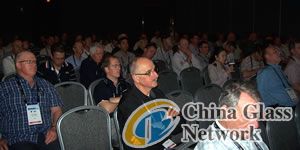Post Time:Sep 27,2011Classify:Industry NewsView:362
Australia's glass and fenestration industry isn't very different from that of the United States. Energy-efficient glazing is just as important to the Australian building market, for example, as it is in the United States. And this year the Australian Glass and Glazing Association and the Australian Window Association joined together for their first Ausfenex, which covered a range of topics, from energy efficiency to "cyclones" and windows. More than 500 participants from both groups took part in the event last week at the Jupiters Hotel & Casino on the Gold Coast in Queensland.
is just as important to the Australian building market, for example, as it is in the United States. And this year the Australian Glass and Glazing Association and the Australian Window Association joined together for their first Ausfenex, which covered a range of topics, from energy efficiency to "cyclones" and windows. More than 500 participants from both groups took part in the event last week at the Jupiters Hotel & Casino on the Gold Coast in Queensland.
The conference opened September 22 with a presentation from Jorma Vitkala, chairman of the Glass Performance Days organizing committee/Glaston Finland Oy, who spoke on "Worldwide Glass & Window Trends." Vitkala covered a range of industry changes, ranging from international business practices to solar glazing.
The global glass market, he began, was approximately 52 million tons in 2010. Much of this, Vitkala said, is coming from China, as more than half the world's float lines are there. He explained that building stock in china is 43-46 billion square meters. In terms of glass, the highest investment there is in coatings; low-E and solar control demand in China will see significant increases in the next few years.
Vitkala also talked about a number of new technologies for architectural glass, such as media facades. "The whole façade is like one big TV screen," he said, explaining that these are constructed with LEDs inside a glass unit. "Another newcomer in LED technology is using it to change the color of glass."
Also talking about color, Vitkala said architects use PVB laminated glass to create colorful façades that are also constructed as safety glass.
Also growing in popularity are glazed balconies, which are commonly used in Australia, as well as Scandinavia.
"Glazed balconies can serve as a buffer against the climate, but also are good for noise reduction," Vitkala said.
Structural engineering projects are also seeing increasing use and Vitkala showed a few examples of such projects. For example, he showed images of the Apple stores, which are well known worldwide for their use of glass as a structural element.
"It's a fantastic idea to use glass [structurally]," said Vitkala, who noted glass can also be used as a load-bearings structural element.
Talking further about glazing trends, Vitkala noted that energy-saving façades also are becoming increasingly important. Requirements for solar control coatings are also increasing, as Vitkala said architectural requirements are seeking to maximize visible transmission and minimize energy transmission into the interior of the building.
As Vitkala explained, when glass is used in a façade it must be thought of as a thermal material. "Highly effective solar control can minimize AC use," he said.
Other growing trends he touched on include double-skin façades, which have been in use in Europe for some time; printing on glass, which can also help with solar control; electrochromic glazing; and free-form architecture.
As far as where the glazing industry is going, Vitkala pointed out that solar glazing is growing rapidly; by 2020 it's expected that 900 million square meters of glass will be used in solar applications. He added that building integrated photovoltaics (BIPV) is the fastest growing area of solar glazing.
"BIPV is very young, but fast growing," said Vitkala. "There are a lot of opportunities for all of us."
Source: http://www.usgnn.comAuthor: shangyi
PrevHighwoods Buys Pittsburgh's PPG Place for $214.1M
A Line of Glass Washing is far from enough for Energy Conservation and Emissions ReductionNext